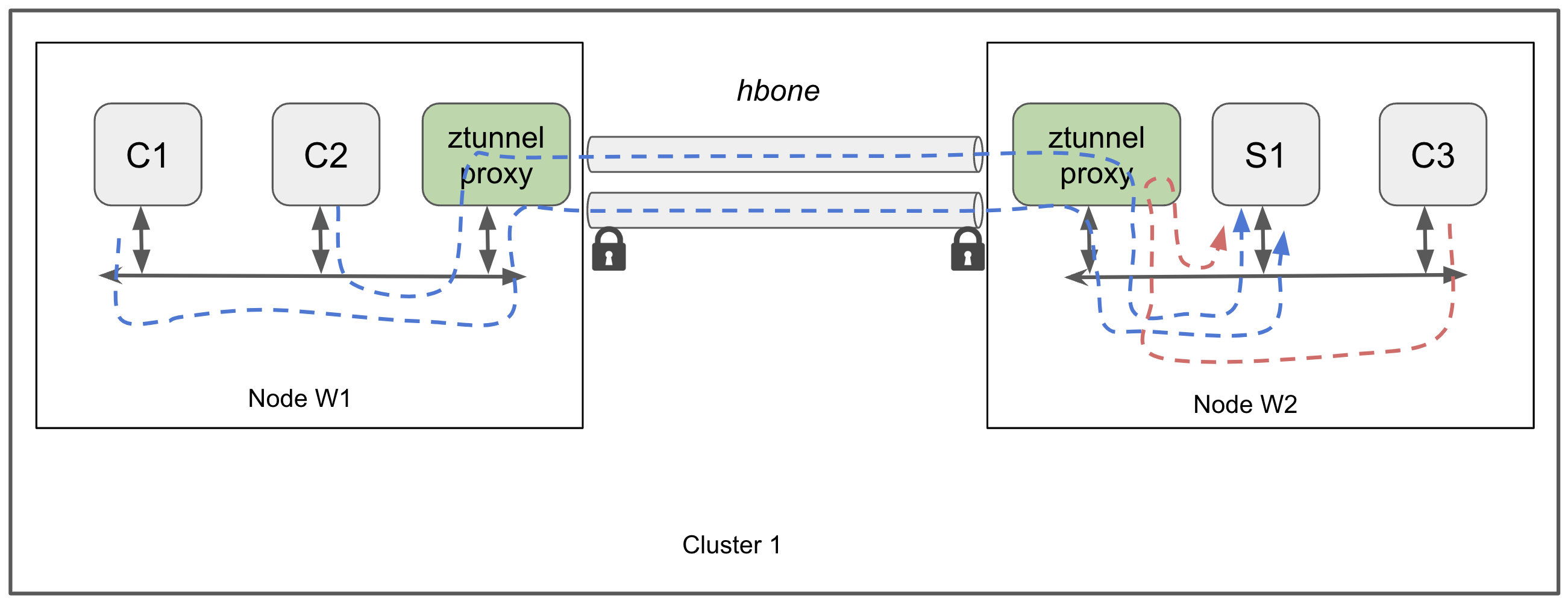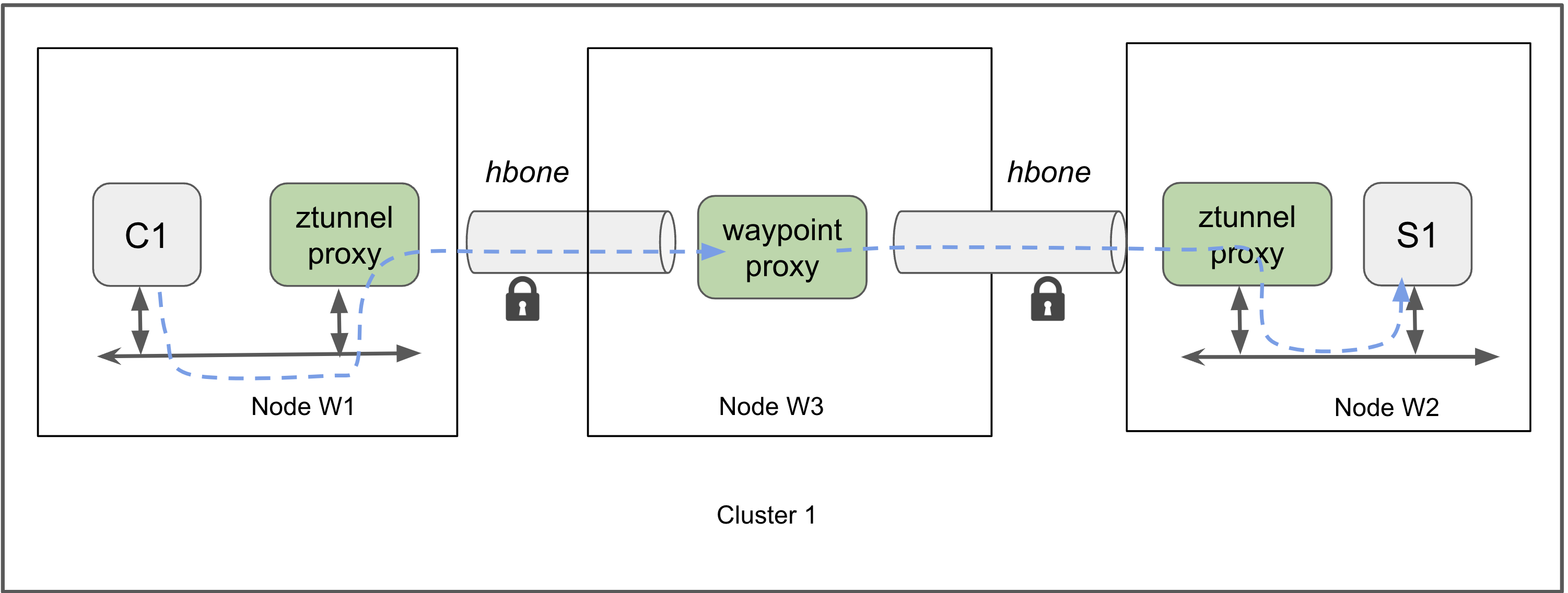Ambient data plane
In ambient mode, workloads can fall into 3 categories:
- Out of Mesh: a standard pod without any mesh features enabled. Istio and the ambient data plane are not enabled.
- In Mesh: a pod that is included in the ambient data plane, and has traffic intercepted at the Layer 4 level by ztunnel. In this mode, L4 policies can be enforced for pod traffic. This mode can be enabled by setting the
istio.io/dataplane-mode=ambientlabel. See labels for more details. - In Mesh, Waypoint enabled: a pod that is in mesh and has a waypoint proxy deployed. In this mode, L7 policies can be enforced for pod traffic. This mode can be enabled by setting the
istio.io/use-waypointlabel. See labels for more details.
Depending on which category a workload is in, the traffic path will be different.
In Mesh Routing
Outbound
When a pod in an ambient mesh makes an outbound request, it will be transparently redirected to the node-local ztunnel which will determine where and how to forward the request.
In general, the traffic routing behaves just like Kubernetes default traffic routing;
requests to a Service will be sent to an endpoint within the Service while requests directly to a Pod IP will go directly to that IP.
However, depending on the destination’s capabilities, different behavior will occur. If the destination is also added in the mesh, or otherwise has Istio proxy capabilities (such as a sidecar), the request will be upgraded to an encrypted HBONE tunnel. If the destination has a waypoint proxy, in addition to being upgraded to HBONE, the request will be forwarded to that waypoint for L7 policy enforcement.
Note that in the case of a request to a Service, if the service has a waypoint, the request will be sent to its waypoint to apply L7 policies to the traffic.
Similarly, in the case of a request to a Pod IP, if the pod has a waypoint, the request will be sent to its waypoint to apply L7 policies to the traffic.
Since it is possible to vary the labels associated with pods in a Deployment it is technically possible for
some pods to use a waypoint while others do not. Users are generally recommended to avoid this advanced use case.
Inbound
When a pod in an ambient mesh receives an inbound request, it will be transparently redirected to the node-local ztunnel. When ztunnel receives the request, it will apply Authorization Policies and forward the request only if the request passes these checks.
A pod can receive HBONE traffic or plaintext traffic. By default, both will be accepted by ztunnel. Requests from sources out of mesh will have no peer identity when Authorization Policies are evaluated, a user can set a policy requiring an identity (either any identity, or a specific one) to block all plaintext traffic.
When the destination is waypoint enabled, if the source is in ambient mesh, the source’s ztunnel ensures the request will go through the waypoint where policy is enforced. However, a workload outside of the mesh doesn’t know anything about waypoint proxies therefore it sends requests directly to the destination without going through any waypoint proxy even if the destination is waypoint enabled. Currently, traffic from sidecars and gateways won’t go through any waypoint proxy either and they will be made aware of waypoint proxies in a future release.
Dataplane details
Identity
All inbound and outbound L4 TCP traffic between workloads in the ambient mesh is secured by the data plane, using mTLS via HBONE, ztunnel, and x509 certificates.
As enforced by mTLS, the source and destination must have unique x509 identities, and those identities must be used to establish the encrypted channel for that connection.
This requires ztunnel to manage multiple distinct workload certificates, on behalf of the proxied workloads - one for each unique identity (service account) for every node-local pod. Ztunnel’s own identity is never used for mTLS connections between workloads.
When fetching certificates, ztunnel will authenticate to the CA with its own identity, but request the identity of another workload. Critically, the CA must enforce that the ztunnel has permission to request that identity. Requests for identities not running on the node are rejected. This is critical to ensure that a compromised node does not compromise the entire mesh.
This CA enforcement is done by Istio’s CA using a Kubernetes Service Account JWT token, which encodes the pod information. This enforcement is also a requirement for any alternative CAs integrating with ztunnel.
Ztunnel will request certificates for all identities on the node. It determines this based on the control plane configuration it receives. When a new identity is discovered on the node, it will be queued for fetching at a low priority, as an optimization. However, if a request needs a certain identity that has not been fetched yet, it will be immediately requested.
Ztunnel additionally will handle the rotation of these certificates as they approach expiry.
Telemetry
Ztunnel emits the full set of Istio Standard TCP Metrics.
Dataplane example for Layer 4 traffic
The L4 ambient dataplane between is depicted in the following figure.
The figure shows several workloads added to the ambient mesh, running on nodes W1 and W2 of a Kubernetes cluster. There is a single instance of the ztunnel proxy on each node. In this scenario, application client pods C1, C2 and C3 need to access a service provided by pod S1. There is no requirement for advanced L7 features such as L7 traffic routing or L7 traffic management, so a L4 data plane is sufficient to obtain mTLS and L4 policy enforcement - no waypoint proxy is required.
The figure shows that pods C1 and C2, running on node W1, connect with pod S1 running on node W2.
The TCP traffic for C1 and C2 is securely tunneled via ztunnel-created HBONE connections. Mutual TLS (mTLS) is used for encryption as well as mutual authentication of traffic being tunneled. SPIFFE identities are used to identify the workloads on each side of the connection. For more details on the tunneling protocol and traffic redirection mechanism, refer to the guides on HBONE and ztunnel traffic redirection.
Note that local traffic - shown in the figure from pod C3 to destination pod S1 on worker node W2 - also traverses the local ztunnel proxy instance, so that L4 traffic management functions such as L4 Authorization and L4 Telemetry will be enforced identically on traffic, whether or not it crosses a node boundary.
In Mesh routing with Waypoint enabled
Istio waypoints exclusively receive HBONE traffic.
Upon receiving a request, the waypoint will ensure that the traffic is for a Pod or Service which uses it.
Having accepted the traffic, the waypoint will then enforce L7 policies (such as AuthorizationPolicy, RequestAuthentication, WasmPlugin, Telemetry, etc) before forwarding.
For direct requests to a Pod, the requests are simply forwarded directly after policy is applied.
For requests to a Service, the waypoint will also apply routing and load balancing.
By default, a Service will simply route to itself, performing L7 load balancing across its endpoints.
This can be overridden with Routes for that Service.
For example, the below policy will ensure that requests to the echo service are forwarded to echo-v1:
apiVersion: gateway.networking.k8s.io/v1
kind: HTTPRoute
metadata:
name: echo
spec:
parentRefs:
- group: ""
kind: Service
name: echo
rules:
- backendRefs:
- name: echo-v1
port: 80The following figure shows the datapath between ztunnel and a waypoint, if one is configured for L7 policy enforcement. Here ztunnel uses HBONE tunneling to send traffic to a waypoint proxy for L7 processing. After processing, the waypoint sends traffic via a second HBONE tunnel to the ztunnel on the node hosting the selected service destination pod. In general the waypoint proxy may or may not be located on the same nodes as the source or destination pod.

